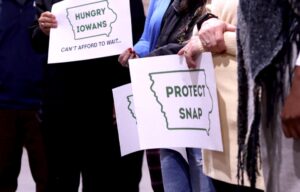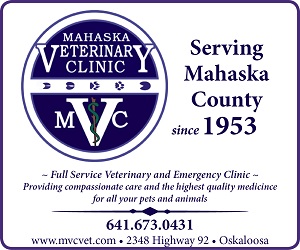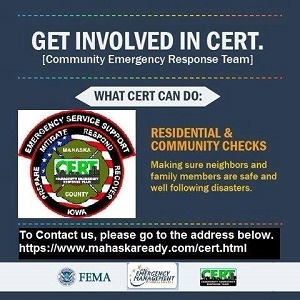Food banks prepare for lapse of SNAP funding, ‘unprecedented’ need due to government shutdown

Food bank and food pantry leaders gathered in Des Moines Oct. 23, 2025 to urge the end of the government shutdown before it causes a lapse in federal nutrition program funding. (Photo by Cami Koons/Iowa Capital Dispatch)
by Cami Koons, Iowa Capital Dispatch
October 23, 2025
As federal funding for the Supplemental Nutrition Assistance Program is days away from running out, food banks, pantries and charitable groups across Iowa are bracing for what they anticipate will be “unprecedented” need.
SNAP serves around than 270,000 Iowans each month and is a federally supported program. But as politicians in Washington, D.C., squabble over budget decisions that determine when the government will reopen, food banks across the state have been asked to support hungry Iowans when current federal funding ends on Nov. 1.
Despite the daunting task ahead, food bank officials have said they are determined to continue their mission to keep folks fed. That mission, they said, can be supported by everyday Iowans via donations of time, funds, nonperishable goods and advocacy to members of Congress.
“There is literally no precedent for this,” said Kathy Underhill, the CEO of Des Moines Area Religious Council, or DMARC. “I wish that there was, because that would make it a lot easier for us to predict what we think is going to happen next … In the history of the SNAP program, benefits have never been delayed or not issued, ever.”
The Iowa Department of Health and Human Services said earlier this month the federal Food and Nutrition Services department instructed states not to issue November SNAP benefits. HHS, in the same news release, said it informed food banks and community organizations to “prepare to provide additional support to impacted Iowans.”
Food banks across the state said they hope the shutdown will end before benefits run out, but will work to keep Iowans fed. That mission, they said, will require creativity and additional support from every community.
Aron Brecht, the community food systems manager with Hawkeye Area Community Action Program, or HACAP, a food bank serving eastern Iowa, said there is no “wrong way” for Iowans to help the sector.
“If you have not given time, or given money, or given food and have always been interested, please allow this to be a scenario where you do that,” Brecht said. “Food banks who provide food to food pantries and meal sites — anybody that’s opening up to help their community right now — we’re all going to need some more help.”
The stakes
The charitable sector, according to Feeding America, is able to provide one meal to every nine meals provided by SNAP dollars.
“I want to be really clear that nonprofits cannot replace SNAP benefits,” Underhill with DMARC, said Thursday at a press conference.
In Polk County alone, where DMARC serves, 50,000 residents receive SNAP benefits. According to DMARC, about half of those recipients are children and seniors.
While food bank and pantry leaders each said the situation was “unprecedented” they also said they plan to do everything they can to meet the need in their communities.
“Regardless of what the future holds we will be here, and we’ll be prepared to help meet the need,” Underhill said. “… if you’re one of our neighbors who is losing sleep about how you and your household will be able to get by, please know that there’s a network here to help you.”
In addition to stocking food pantries, food banks are often involved in after school and weekend feeding programs that help keep children fed when schools are closed.
Barb Prather, executive director for Northeast Iowa Food Bank, said these programs, along with mobile food pantries, are some of the most important programs her food bank does to serve rural communities.
The word “unprecedented” was used consistently to describe impacts of the COVID-19 pandemic, but Prather said the current situation feels “worse to some degree” because during the pandemic there were additional resources available for food banks to tap into.
“Food banks can’t make up the difference in SNAP or WIC or any of those government programs, but we at the Northeast Iowa Food Bank have a commitment to feed people, and we’ll do everything in our power to be able to hopefully meet that commitment and encourage communities to rise up and help us in doing that,” Prather said.
Stephanie Sullivan, the assistant director of communications and marketing for Food Bank for the Heartland, which serves western Iowa and eastern Nebraska, said the impact of the shutdown will have “ripple” effects for thousands of people in her region, for months to come.
“We know that our neighbors are already making unthinkable decisions whether they choose between going to the grocery store or paying their medical bills and no one should be forced into that decision,” Sullivan said.
Beyond the food security sector, SNAP has an economic multiplier factor of up to 1.5, according to U.S. Department of Agriculture data. Under that multiplier, the estimated $45 million in SNAP dollars spent in Iowa each month generates nearly $70 million in economic activity.
The timing of the shutdown also follows historic cuts to the SNAP program from the Republican-led “one big beautiful” law, which a nonpartisan government analysis estimates will cut 20% of funding to the program through 2034.
It’s estimated the cuts will result in a loss of $50 million in funding for the program in Iowa for 2026, with greater losses in subsequent years.
Sullivan said the cuts to SNAP while her food bank faces historic need makes it feel like the food bank is “climbing an uphill battle” to deploy its mission.
“Because we haven’t seen a need this high in our history, on top of all the other challenges we’re facing, this is a hunger epidemic, what we’re facing right now,” Sullivan said.
Three ways to help
Underhill with DMARC, which is the largest food pantry in Des Moines, said the pantry is increasing its food on hand by about 25% and remaining in contact with partners across the metro to “ensure that there are no interruptions in daily service.”
According to Underhill, the pantry has no intentions to limit the amount of food it guarantees to visitors, nor to alter its services.
Brecht with HACAP said need increases in the food sector any time there is a real or perceived threat to benefits. He said partners in his region have said their communities are already preparing for that lapse in benefits to occur. For SNAP recipients, that might mean trying to stretch their October allotments, or making an extra trip to the food pantry.
“We’re purchasing more food in anticipation for any sort of expanded shutdown to try to at least bolster our inventory and do our best to meet whatever need comes through the next week, month, etc.” Brecht said.
Brecht said eligible Iowans can continue to sign up for SNAP, and he said they also should keep their electronic benefits cards — even if the shutdown persists into November — so that funds can be distributed quickly when they do become available.
Brecht and the other food bank officials pointed to advocacy as one of the most important ways that Iowans can help during this time.
“Local, state, federally elected officials all need that education from folks that are that are concerned and folks that are either utilizing programs or have some insight,” Brecht said.
Gov. Kim Reynolds singled out congressional Democrats Thursday morning in a news release and called on her opposing party to end the shutdown before it caused “disruption” to SNAP benefits.
“Because SNAP is fully funded and operated by the federal government, states are unable to step in and keep it running,” Reynolds said in the release. “But this issue could be resolved today if Senate Democrats would vote to reopen the government. If they continue to refuse, they’ll be choosing to put low-income American families at risk.”
Republicans and Democrats in D.C. continue to be at odds and stalemate on key bills that would reopen the government.
In addition to calling for an end to the shutdown, Reynolds directed Iowa HHS to remain in “regular contact” with Iowa food banks about their current inventories and abilities to increase distribution if necessary.
“Our focus in Iowa will be on understanding the needs of food banks and pantries across the state and applying what we learned during the pandemic to support SNAP households if benefits are delayed,” Reynolds said.
Prather with Northeast Iowa Food Bank said the state has been a “great partner” in the past and she appreciates the governor’s actions.
“It takes all of us to make a difference in the lives of people in Iowa, not only private but also public support in that as well,” Prather said. “I’m optimistic that we’ll be able to work with her to help alleviate the need if the government continues to be closed.”
As Underhill put it, “many hands make light work.” In addition to calling and emailing congressional leaders, food bank leaders said Iowans can also volunteer at their local food pantries to help pack and organize donations, or they can make monetary or nonperishable food item donations.
While all donations are appreciated, the food bank leaders said monetary donations are especially prioritized because food banks and pantries have wholesale partnerships that allow them to spread each dollar further.
If an organization is planning to host a food drive, or someone wants to donate food items instead, Underhill said things like canned goods, peanut butter, rice, boxed pasta, cereal, canned chicken and dried beans are some of the most useful items to donate.
Other food banks echoed the same sentiments and said they are doing all they can to beef up their warehouses in anticipation of the need.
Annette Hacker, communications manager for Food Bank of Iowa said while the food bank has “sound financial footing,” its resources are “not unlimited.”
“We really can’t continue at the rate we’re going with purchased food,” Hacker said. “That said … we’ve been here a long time and will continue to be here, but we’re going to have to get more and more creative on how we source that food, how we deliver that food, how we fundraise. It is a very very challenging time.”
Food bank websites provide information on donations and on food pantries in the area.
Iowa Capital Dispatch is part of States Newsroom, a nonprofit news network supported by grants and a coalition of donors as a 501c(3) public charity. Iowa Capital Dispatch maintains editorial independence. Contact Editor Kathie Obradovich for questions: info@iowacapitaldispatch.com.















